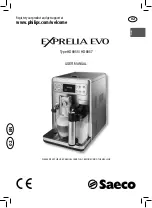
32
ENGLISH
• Close supervision is necessary when the machine is
used near children.
• This machine is not intended for use by young or infirm
persons without supervision.
• This machine is not to be used as a toy.
• Only use the machine in daylight or good artificial light.
• If the machine starts to vibrate abnormally or if you hit
a foreign object, switch the appliance off and remove
the plug from the socket. Check for any damage to the
appliance, replace or repair any damaged parts, check
for and tighten any loose parts.
• Avoid using the machine in bad weather conditions
especially when there is a risk of lightning.
• Use in a dry location only.
• Do not allow the machine to become wet.
• Do not immerse the machine in water.
• Do not open the body casing. There are not userserviceable
parts inside.
• Do not operate the machine in explosive atmospheres,
such as in the presence of flammable liquids, gases or dust.
• To reduce the risk of damage to plugs or cords, never
pull the cable to remove the plug from a socket.
Safety of Others
• ff Never allow children, persons with reduced physical,
sensory or mental capabilities or lack of experience and
knowledge or people unfamiliar with these instructions
to use the machine, local regulations may restrict the
age of the operator.
• Children shall not play with the machine.
• Cleaning and user maintenance shall not be made by
children without supervision.
Residual Risks
Additional residual risks may arise when using the tool
which may not be included in the enclosed safety warnings.
These risks can arise from misuse, prolonged use etc.
Even with the application of the relevant safety regulations
and the implementation of safety devices, certain residual
risks can not be avoided. These include:
• Injuries caused by touching any rotating/moving parts.
• Injuries caused when changing any parts, blades or
accessories.
• Injuries caused by prolonged use of a tool. When using any
tool for prolonged periods ensure you take regular breaks.
• Impairment of hearing.
• Health hazards caused by breathing dust developed
when using your tool (example:- working with wood,
especially oak, beech and MDF).
Vibration
The declared vibration emission values stated in the
technical data and the declaration of conformity have
been measured in accordance with a standard test method
provided by EN50636 and may be used for comparing one
tool with another. The declared vibration emission value
may also be used in a preliminary assessment of exposure.
WARNING:
The vibration emission value during
actual use of the power tool can differ from the
declared value depending on the ways in which the
tool is used. The vibration level may increase above
the level stated.
When assessing vibration exposure to determine safety
measures required by 2002/44/EC to protect persons
regularly using power tools in employment, an estimation
of vibration exposure should consider, the actual conditions
of use and the way the tool is used, including taking
account of all parts of the operating cycle such as the times
when the tool is switched off and when it is running idle in
addition to the trigger time.
After Use
• When not in use, the machine should be stored in a dry,
well ventilated place out of reach of children.
• Children should not have access to stored machines.
• When the machine is stored or transported in a vehicle
it should be placed in the boot or restrained to prevent
movement following sudden changes in speed or
direction.
Inspection and Repairs
• Before use, check the machine for damaged or defective
parts. Check for breakage of parts and any other
conditions that may affect its operation.
• Do not use the machine if any part is damaged or
defective.
• Have any damaged or defective parts repaired or
replaced by an authorised repair agent.
• Never attempt to remove or replace any parts other
than those specified in this manual.
Extension Cords
Make sure your extension cord is in good condition. When
using an extension cord, be sure to use one heavy enough
to carry the current your product will draw. An undersized
cord will cause a drop in line voltage resulting in loss of power
and overheating. The following table shows the correct size to
use depending on cord length and nameplate ampere rating.
If in doubt, use the next heavier gage. The smaller the gage
number, the heavier the cord.
Minimum gage for cord sets
Volts
Total length of cord in feet (ft)
120 V - 127V
0 - 25
26 - 50
51 - 100
101 - 150
220 V
0 - 50
51 - 100
101 - 200 201 - 300
Ampers
Wire gauge in square millimeters
(mm
2
)
More
than
No more
than
0
6
1,0
1,5
1,5
2,5
6
10
1,0
1,5
2,5
4,0
10
12
1,5
1,5
2,5
4,0
12
16
2,5
4,0
Not recommended
ADDITIONAL SAFETY INSTRUCTIONS FOR
STRING TRIMMERS
WARNING:
Cutting elements continue to rotate after
the motor is switched off.









































